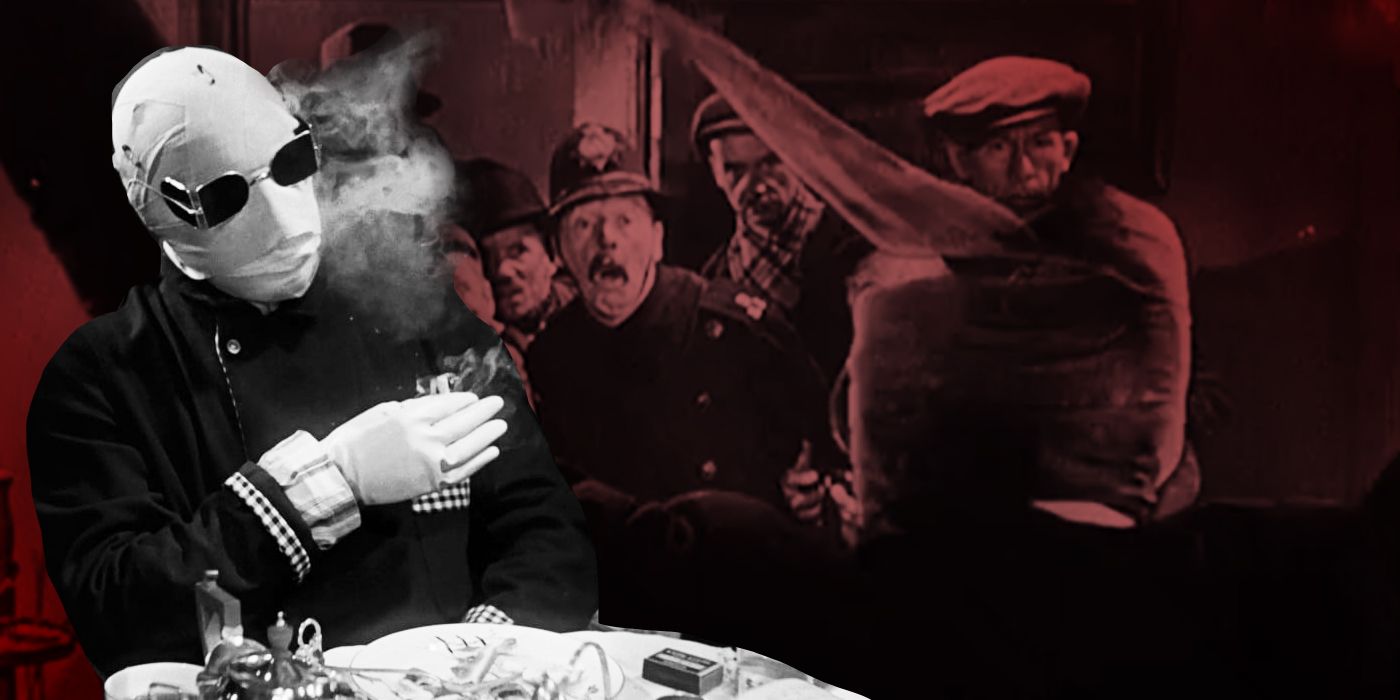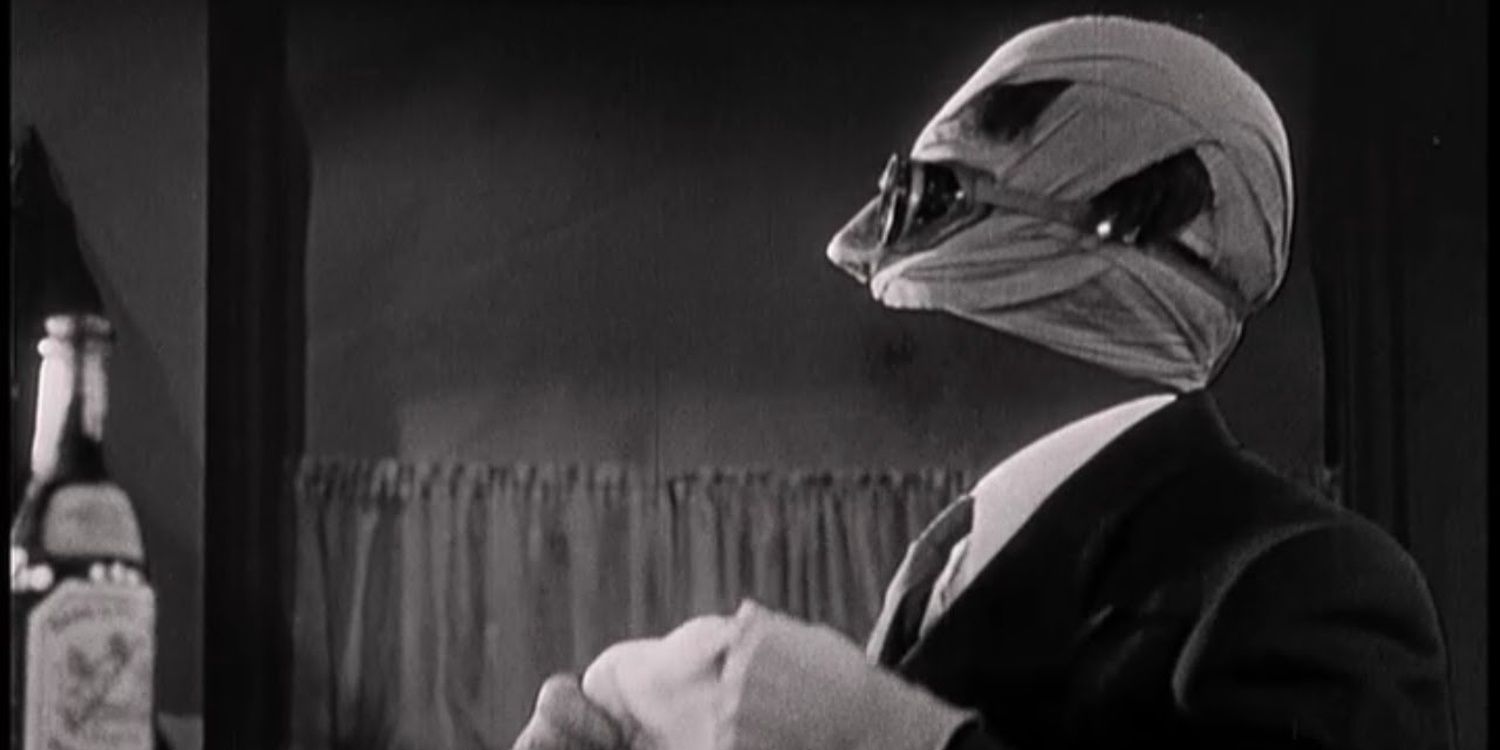Universal's original The Invisible Man features iconic scenes of its titular character removing his clothing, revealing that he is invisible underneath; no doubt, most audiences leave the film wondering how the special effect was done — especially decades before CGI. Universal's 2020 remake, also titled The Invisible Man, frightens it viewers with its villainous invisible monster: an abusive ex-boyfriend who uses his invisibility to torment protagonist Cecilia Kass (Elisabeth Moss). Both films feature similar scenes with objects floating in mid-air and footprints suddenly appearing on surfaces, seemingly out of nowhere. While the effects in the 2020 version are certainly thrilling, they aren't as impressive as the 1933 effects, which had to be accomplished without CGI technology.
The Invisible Man is a book by H. G. Wells, published in 1897. The book's plot revolves around a scientist studying optics who discovers a chemical process that can turn a physical being invisible. After testing his new discovery on a cat, he successfully turn himself invisible — but is unable to reverse the procedure. Being invisible only encourages his sociopathic tendencies, and the scientist, Griffin, quickly gives in to his criminal urges, committing burglary, acts of violence, and even murder.
Wells' book was first adapted for the silver screen in 1933, and the Invisible Man is a part of Universal's Classic Monsters. James Whale directed the film, which starred Claude Rains as the scientist Dr. Jack Griffin. Interestingly enough, the movie almost wasn't made, because the studio had difficulty securing Wells' approval. In all, seven different treatments were submitted to Wells, before he finally approved the script penned by novelist John Weld, who was the only writer to actually base his treatment on the source material. Wells approved his treatment and production of The Invisible Man begun. One problem remained, however: how was Whale going to convince audiences that there was an invisible human being onscreen?
The Invisible Man (1933) Practical Effects
When Griffin, played by Rains, is onscreen, he is often seen wrapped in bandages and fully clothed; however, the story called for numerous instances in which Griffin commits acts while invisible. Whale realized he would have to give the (invisible) character subtle things to do onscreen that would indicate his presence, such as a chair sinking slightly as it's sat upon, then scooted forward when Griffin wants to talk confidentially. The special effects team, lead by industry legend Arthur Edeson (cinematographer for iconic film noirs like The Maltese Falcon), created the effect in The Invisible Man (1933) largely with a combination of practical effects using hidden wires and stagehands, which were sold through the pantomime of other actors onscreen.
In his biography on James Whale, James Whale: A New World of Gods and Monsters, James Curtis describes the process of achieving the practical effects in The Invisible Man (1933):
Wires were used to lift books, bottles, and the cashier's tray from a bank. Stagehands out of camera range were enough to close doors and shift chairs, while pantomime was effective for actors manhandled by the invisible character. One of the more impressive mechanical shots was Griffin's theft of a bicycle, which goes speeding down a village street — suspended by wires from an overhead boom and rolled along on a hidden track.
Another major special effect in The Invisible Man is Griffin walking through the snow. The scene is iconic and has been imitated in several other The Invisible Man adaptations, including Universal's updated 2020 monster movie. The footprints were created through a system of footprint-shaped platforms, held in place with pegs, underneath a layer or rock salt, which emulated snow. As the pegs were pulled, the platform would drop, creating the "footprint." The crew pulled the pegs in sequence, which on film gave the appearance of Griffin walking.
The Invisible Man (1993) Invisibility Effects In Post-Production
Arguably, the most iconic scene in the original The Invisible Man movie is the shot of Griffin removing his bandages and glasses, revealing nothing underneath. The sequence is still impressive today, and could not be achieved using practical effects like wires or stagehands. Without CGI and green screen technology, the production team had to figure out a way to use post-production film editing techniques to create the illusion. Whale relied on specialist John P. Fulton, who came up with an ingenious strategy for make Griffin appear invisible by layering multiple prints of the film with two different exposures. Curtis describes the process in his biography on Whale:
[Fulton] began with the normal filming of a scene, but with Claude Rains completely out of the shot. With the action carefully timed, the negative would be developed in the usual manner. The same set would then be draped entirely in black velvet, with Rains in black tights, black gloves, and a black headpiece fashioned from the cast made earlier of his head. Over this Rains would wear any clothing required for the shot [...]
From the film of the unsupported clothes, two high-contrast duplicates — called "mattes" — were made. One had the effect of blocking out the background, while the other blocked out the partially-clothed Invisible Man. Then all four pieces of film — the background, the clothes, and their respective mattes — were combined in the making of a single composite.
The effect wasn't perfect, and according to Curtis, the film negatives required men to paint over imperfections in the film using an opaque dye: a process that hid the small details the cameramen were unable to obscure during filming. The process was no doubt tedious and expensive, but the resulting effects were breathtaking.
The Invisible Man, which was a very expensive and long production for Universal, opened to rave reviews, and became an important money-maker for the studio. Whale would go on to direct one more big budget horror film for Universal, The Bride of Frankenstein in 1935; however, by then, both Whale and audiences in general had lost enthusiasm for the genre. Like the other successful Universal Classic Monster movies, The Invisible Man received numerous (lower budget) sequels in the subsequent years, and it s titular monster made appearances in "monster mash" ensemble movies like Abbott and Costello Meet Frankenstein (1948). It's no surprise that Universal chose the character for a 21st-century reboot, given that his psychological villainy is more easily translated to a convincingly-frightening contemporary horror story than the campy monsters from other properties; while the Dark Universe's future is unknown, perhaps The Invisible Man will help sustain the studio's horror department for the immediate future, just as the 1933 version did for the studio decades ago.


